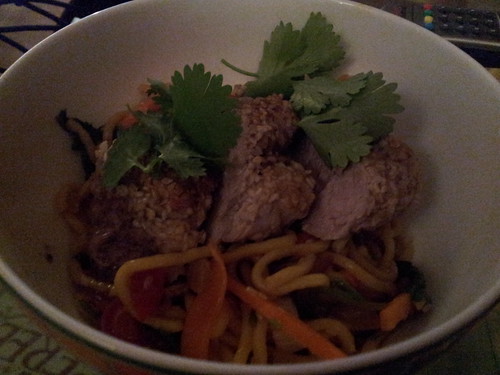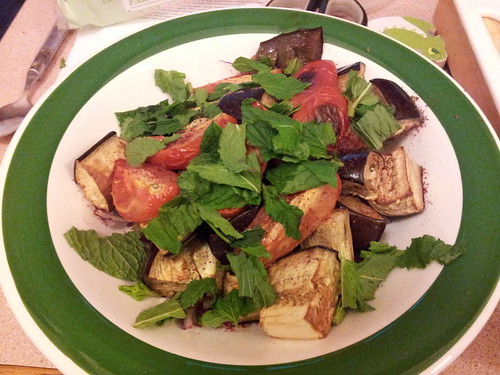We eat quite a lot of salmon in our household: the toddler enjoys tinned salmon (Tasmanian, of course) as a snack/lunch/easy dinner, we all love fresh salmon (especially the crispy skin!) and smoked salmon is popular too. One thing we miss, which we used to eat a lot of in England, is hot smoked fish. ‘Normal’ smoked salmon is cold smoked, so the fish is effectively not cooked (it is cured beforehand). Hot smoking uses hot smoke, so the fish is both cooked and preserved by the smoking process. While smoked salmon is normally sold finely sliced, hot smoked salmon is sold in steaks. If you don’t like smoked salmon, give hot smoked a go, because it’s very different.
Anyway, when I spotted this recipe, using both hot smoked salmon AND soba noodles, I had to give it a go. It has very few ingredients, but you might struggle to find the frozen edamame unless you go to a specialist Asian food store. Soba are pretty easy to find although the ones I bought from the supermarket were about 75% wheat and only 25% buckwheat. If you have the time and inclination, seek out a higher proportion of buckwheat.
Begin by making the ponzu sauce. To the juice of one lemon add 1 tbsp rice wine vinegar, 2 tbsp of soy sauce, ½ tsp caster sugar and 1 tsp of sesame oil. Mix to dissolve the sugar and set aside.
Take your hot smoked salmon (I used one 185g packet between the two of us) and, if the skin is still on, remove it. Straight from the packet it will be extremely tough and really quite unpleasant. You can always have a go frying it up if you wish! Flake the fish (equally!) into two bowls. Into each bowl add a finely sliced spring onion, some julienned carrot and some julienned cucumber. I used these in lieu of the edamame; I suggest you use whatever is in the fridge!
You could easily do all this in advance. At this point, cover your bowl(s) with cling film and pop in the fridge until you are ready. If you prefer the salmon at room temperature (like me) don’t forget to take them out half an hour or so before you want to eat.
When you’re ready to serve, cook some soba noodles in boiling water. Be careful not to overcook because they will become a bit soggy and claggy if you do. The ponzu will help separate the noodles and perk them up, but you’re much better off opting for al dente.
Top the salmon and vegetables with the soba, pour over the ponzu and sprinkle on a few sesame seeds (toasted if you can be bothered).
Not only does this taste really good, but it’s easy, quick and insanely healthy.
This alone did us for dinner (though we did wrap up the evening with a sneaky chocolate!). It would also serve well as a salad to serve as part of a more extravagant meal, or a light entrée. Aside from the salmon and noodles, it’s flexible and the ponzu is easily made from store cupboard ingredients. Andy did comment that he thought next time some finely sliced fresh chillis would be a welcome addition. If you do want to spice it up, you could also use chilli oil in lieu or (or as a part substitute for) the sesame oil.



